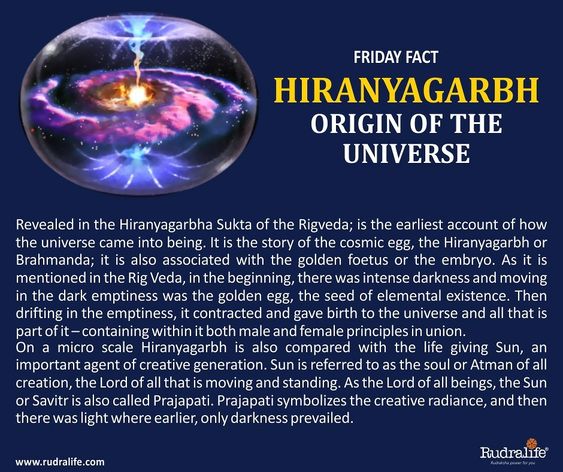
Prajapati (Sanskrit: प्रजापति) is a compound of "praja" (creation, procreative powers) and "pati" (lord, master). The term means "lord of creatures", or "lord of all born beings". In the later Vedic texts, Prajapati is a distinct Vedic deity, but whose significance diminishes. Later, the term is synonymous with other gods, particularly Brahma. Still later, the term evolves to mean any divine, semi-divine or human sages who create something new.
According to Robert Graves, the name of /PRA-JĀ[N]-pati/ ('progeny-potentate') is etymologically equivalent to that of the oracular god at Colophon (according to Makrobios), namely /prōtogonos/.[citation needed] The cosmic egg concept linked to Prajapati and Protogonos is common in many parts of the world, states David Leeming, which appears in later Orphic cult in Greece.
In the Rigveda, Prajapati appears as an epithet for Savitr, Soma, Agni and Indra, who are all praised as equal, same and lord of creatures.[ Elsewhere, in hymn 10.121 of the Rigveda, is described Hiranyagarbha (golden embryo) that was born from the waters containing everything, which produced Prajapati. It then created manah (mind), kama (desire) and tapas (heat). However, this Prajapati is a metaphor, one of many Hindu cosmology theories, and there is no supreme deity in the Rigveda. One of the striking features about the Hindu Prajapati myths, states Jan Gonda, is the idea that work of creation is a gradual process, completed in stages of trial and improvement.
In the medieval era texts of Hinduism, Prajapati refers to legendary agents of creation, working as gods or sages, who appear in every cycle of creation-maintenance-destruction (manvantara). Their numbers vary between seven, ten, sixteen or twenty-one.
Hindu temples in Bali Indonesia called Pura Prajapati, also called Pura Mrajapati, are common. They are most associated with funeral rituals and the Ngaben (cremation) ceremony for the dead.



The Orphic Egg in the Ancient Greek Orphic tradition is the cosmic egg from which hatched the primordial hermaphroditic deity Phanes/Protogonus (variously equated also with Zeus, Pan, Metis, Eros, Erikepaios and Bromius) who in turn created the other gods.[1] The egg is often depicted with the serpent-like creature, Ananke, wound about it.
In Greek myth, particularly Orphic thought, Phanes is the golden winged primordial being who was hatched from the shining cosmic egg that was the source of the universe. Called Protogonos (First-Born) and Eros (Love) — being the seed of gods and men — Phanes means "to bring light" or "to shine" and is related to the Greek "to shine forth" as well as the Latin "Lucifer". An ancient Orphic hymn addresses him thus:
Ineffable, hidden, brilliant scion, whose motion is whirring, you scattered the dark mist that lay before your eyes and, flapping your wings, you whirled about, and through this world you brought pure light.




Note the appearance of the Egg in the Hieroglyph of Maat

Heh, the god of millions of years
Neheh vs. Djet time: The Afterlife is not eternal







Ophiuchus (/ɒfiˈjuːkəs/) is a large constellation straddling the celestial equator. Its name is from the Greek Ὀφιοῦχος (Ophioukhos, "serpent-bearer"), and it is commonly represented as a man grasping a snake (symbol ⛎, Unicode U+26CE). The serpent is represented by the constellation Serpens. Ophiuchus was one of the 48 constellations listed by the 2nd-century astronomer Ptolemy, and it remains one of the 88 modern constellations. An old alternative name for the constellation was Serpentarius (/sɜːrpənˈtɛəriəs/).
Ophiuchus lies between Aquila, Serpens, Scorpius, Sagittarius, and Hercules, northwest of the center of the Milky Way. The southern part lies between Scorpius to the west and Sagittarius to the east. In the northern hemisphere, it is best visible in summer. It is opposite of Orion.



No comments:
Post a Comment
Note: Only a member of this blog may post a comment.